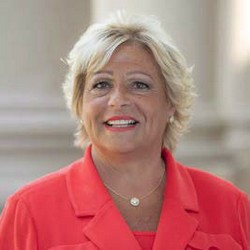Pedram Daneshgar, Ph.D., Professor of Biology, presented the penultimate educational Climate Crisis Teach-In event on Tuesday, April 4. The event, titled, “Ghost Forests: What’s lost and What’s Gained?” explained the emergence of “Ghost Forests” and their ecological impacts.
The term “Ghost Forests” refers to an area of dead trees that have been exposed to water, storms, and/or potentially damaging salt. “I find them haunting,” Daneshgar explained. “It’s like walking in a cemetery because you’re walking among what was once a thing, and now it’s not.” Daneshgar is also a plant ecologist who specializes in climate change impacts on coastal forests in New Jersey and The Bahamas.
Daneshgar emphasized that ghost forests are directly tied to climate change, and that there’s both gradual and rapid ways for them to emerge. “The gradual way is through sea-level rise in a coastal habitat… The sea level rising causes bay waters to creep inland, and the salt exposure from sea water causes the trees (on the island) to die,” Daneshgar explained.
He also noted that rising sea-levels also causes flooding inland, killing forests along lowlands, “The cause of death for these trees is either salt exposure which dries them out, or they basically suffocate, because trees breathe through their roots. So, you can see that only the trees that are in elevated areas where they can escape the sea level rise (SLR) are able to survive for a long time.”
An experiment was conducted on eight of the most common native NJ coast tree species to see which could best weather salt exposure and flooding. “These trees all respond to salt damage in different ways. Some will pull salt up in their leaves, shed their leaves, and then form new leaves. Some just dry out and die immediately,” Daneshgar explained.
One of the main points of the event is that the emergence of ghost forests results in a habitat unsuitable for mammals. Instead, birds of prey take over the habitat due to the large open space that allows them to “sit up there and watch,” according to Daneshgar. The title of the event, “What’s Lost and What’s Gained,” refers to how “you lose habitat in one sense, but gain habitat in another,” as Daneshgar explained.
“There’s something gained there with dead trees. Osprey were under threat in the ‘50s and ‘60s, but their populations have recovered to the point where they’re not completely a species of concern anymore, but this does present a new habitat for them.”
Scientists are carefully monitoring the ecosystems of ghost forests using a variety of technologies and strategies. One such strategy is “using software to listen to the sounds of these animals and what they’re doing, and using that to help identify them. We see patterns in what we hear… so we hear different composition, different animals (before and after the emergence of Ghost Forests),” Daneshgar said. He also noted that arial imagery helps show where ghost forests have emerged, allowing scientists to note where plants are impacted.
Over 20 individuals were in attendance at the event, which concluded with about 30 minutes of audience Q&A.
Organized by Catherine Duckett, Ph.D., Associate Dean of the School of Science, the climate crisis teach-in began in 2019 and aims to “generate discussion about climate impacts and solutions with the goal of improving life for humans and other living things,” according to their website. The next event, “Ecological Restoration Project for the Climate Crisis” will take place on Earth Day, April 22 from 9:30-11:30 a.m. at Van Court Park in Long Branch.



